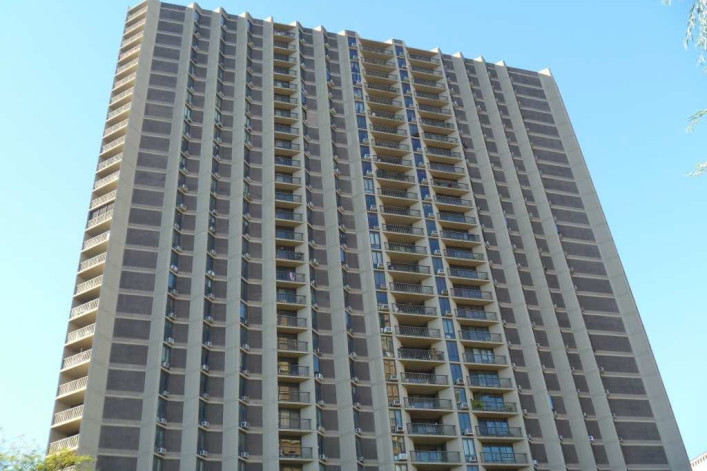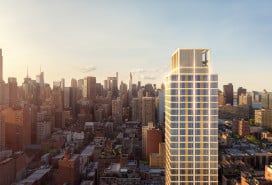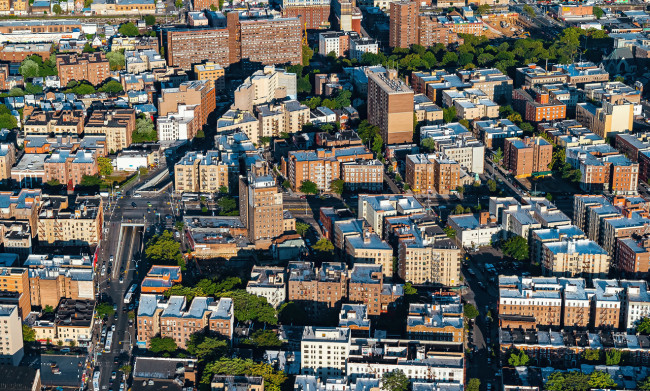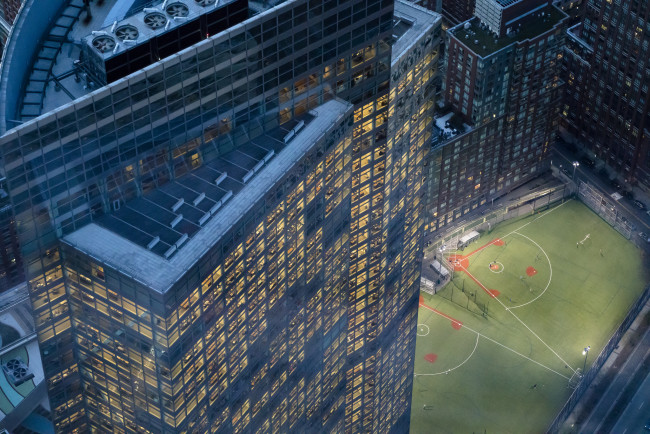Hit the NYC jackpot: How to get an affordable Mitchell-Lama apartment to call your own

101 Clark St., one of two buildings that make up Cadman Towers, a Mitchell-Lama development in Brooklyn Heights, at the foot of the Brooklyn Bridge.
A one-bedroom in Chelsea for $85,000? In a neighborhood where similar co-ops routinely fetch ten times that amount, it seems like a real estate fantasy. But it’s not.
Such apartments can become available through Mitchell-Lama, an affordable housing program that provides rentals and co-ops to middle-income New Yorkers. Constructed in the 1950s and 1960s, these buildings often have wait lists that stretch on for years, and it’s not hard to see why. Apartments in the program tend to be well-kept and large, often with 24-hour security, community rooms, and parking spaces.
[Editor's note: A version of this piece was first published in 2014.]
Despite the wait lists, it’s still possible to snag one of these apartments. We spoke to Mitchell-Lama experts and residents for their best advice on how to get one. Here's our step by step guide.
So what exactly is a Mitchell-Lama?
Named after two politicians, New York State Senator MacNeil Mitchell and Assemblyman Alfred Lama, who sponsored the bill that created it, the program dates back to 1955. That’s when the city cleared sites in formerly rundown parts of town, from Chelsea to the Upper East Side, and developers constructed about 105,000 apartments in 269 Mitchell-Lama buildings.
The housing is made up of income-restricted rentals and “limited equity” co-ops. Rents are tied to a tenant’s income, and co-op prices are set so that buyers pay an “equity value,” which they get back when they sell, meaning there’s no profit to be made. In exchange for keeping these places affordable, the builders get tax breaks and low-interest mortgages. The last Mitchell-Lama was built decades ago.
These days, only about 45,000 Mitchell-Lama apartments are left, two-thirds of which are co-ops.
The reason for the drop is that buildings can exit the program. In the case of co-ops, after the building has paid off the mortgage and either 25 or 35 years has passed (depending on its age), shareholders can vote to leave Mitchell-Lama. For current residents, this means a potential windfall, since they can sell their apartments at market rates. In the case of rental buildings, the landlord can take the property out of the program once the mortgage is paid off and 20 years have passed, within certain limits, according to Tenants and Neighbors. And some early Mitchell-Lama buildings carried 50-year affordability requirements.
In 2017, Mayor de Blasio announced a plan to spend $250 million to help 15,000 Mitchell-Lama apartments remain affordable by offering owners tax exemptions and low interest loans in exchange for extending their participation in the program. The Village Voice reports that Mitchell-Lama tenants are concerned that there's still little incentive for landlords to remain in the program.
Do I qualify?
Getting a Mitchell-Lama depends on two main eligibility requirements: income and family size. In other words, the number of people in your household has to match up with the bedroom count of the apartment—no singletons taking up three-bedroom units—and your income must be under a certain limit.
Broadly speaking, the range for co-ops is $53,450-$83,526 for a single person and $76,300-$119,219 for a family of four, but full details are available on HPD’s website, and every building has slightly different requirements. For rentals, income limits are set at the area median income or seven times the annual rent, including the cost of electricity, water, and cooking fuel. Income is calculated based on two years of tax returns.
Where do I find one?
Mitchell-Lamas are located all over the city, but when it comes to actually getting into one, they’re split into two groups that have nothing to do with geography.
The first type of building maintains an “open” waiting list, where anyone can add their name at any point. Prepare to wait upwards of a decade to get to the head of one of these lists. Other buildings are “closed” and won’t take names—they already have enough people signed up to fill apartments for the foreseeable future. However, occasionally these buildings exhaust their roster of names and open the list to the public. Buildings have separate tallies for each bedroom count, so they may take names for studios and one bedrooms but not for larger apartments, for example.
When a Mitchell-Lama complex is preparing to open a list, the building must announce it in local newspapers. More practically, the Department of Housing Preservation and Development offers a web portal called Mitchell-Lama Connect that shows you open wait lists. Signing up also automatically enrolls you to be notified by email when waiting lists open up. If you already have an account on the affordable rental portal NYC Housing Connect, you should be able to use that.
How do I get one?
Play the lottery
Don’t expect that just because a closed list opens you can automatically add your name to it. Instead, a building will hold a lottery for people to get on the waiting list, picking a few hundred names at random and adding them in order.
Each Mitchell-Lama has a slightly different process for entering the lottery, but generally, you have to mail the building a postcard with your name and address. For specifics, check the notice announcing the opening of the waiting list or call the building for details. You can only send in one postcard per building; you’ll be disqualified if you send in multiple cards. Similarly, you can only apply for a single list—meaning only one bedroom count—per building.
Follow the building's instructions closely. If you don’t get your postcard to the building, there’s not a whole lot you can do. HPD can’t tell you whether they’ve received your postcard or not (though they do keep track of the cards they receive), according to Joseph Quigley, HPD's director of administrative services, who works closely on the Mitchell-Lama program.
That said, you don’t have to limit yourself to one Mitchell-Lama development at a time.
“The advice I would give an applicant would be to apply to as many of the developments as they would like,” Quigley says, adding, “It doesn’t cost you anything, other than the cost of the postcard.”
And feel free to go wild with your postcard selection: “We get lots of interesting postcards—some that are homemade,” Quigley says. “They’re all considered postcards. They all get treated equally.”
Snag your spot on the waiting list
If your name is selected in the lottery, you’ll get an envelope with an application to get on the waiting list. Keep in mind, it may take up to two years to hear from the building, Quigley says, especially if your name was one of the last chosen in the lottery.
At this point, all you have to do is provide contact information, not financial documents, says Dean Roberts, a real estate attorney at Norris McLaughlin & Marcus who has spent much of the last three decades working with Mitchell-Lama buildings. Income determinations are only made when you’re preparing to buy or rent the apartment, so you can add your name to the wait list even if you don’t meet the income limits right then.
However, be sure to submit a valid mailing address. Some co-ops send out mailings to make sure people on the list are still interested, and if they don’t hear from you after a couple of times, they may kick you off, Roberts advises.
Wait… and wait some more
Once you’ve cleared the hurdles of the lottery and gotten your name on a waiting list, prepare to sit tight. It could be years—or even decades, depending on how desirable the apartments are, and how quickly they turn over—to move to the top.
Tracie Hunte, an assistant producer at WNYC, described getting on the waiting list for Cadman Towers, a Brooklyn Heights co-op, in 2010. She landed her 600-square-foot one-bedroom about three years later. It cost $38,000.
Patience is key, as the wait can easily take even longer. In the meantime, “the trick is to keep your stuff updated,” Roberts advises. Sends a letter to each building with a self-addressed stamped envelope every year to be sure you're still on the list. (Sample text is available here.)
Buy or rent your apartment
When you reach the coveted top spot on the waiting list, you’ll hear from building management. They’ll invite you to come to the property with your income and family documents in hand, Quigley says. Expect to provide two years of tax returns and, if applicable, birth certificates for your children, among other documents.
For rentals, some management companies will check your credit history, though it’s not required by HPD, Quigley says. Theoretically, the landlord could reject you if you have bad credit, but many companies will let you use a guarantor or give you a chance to clear up any issues, Quigley says. “We’ve tried to be flexible with people,” he adds.
On the co-op side, some boards hire a third party to conduct a home inspection, but they’re mostly looking for major issues like hoarding or owning pets against building rules, Roberts says. For the most part, buying a Mitchell-Lama is a lot less complicated than purchasing your average co-op because there’s no traditional board approval process—no board interview, no reference letters, no mysterious rejections for personal reasons.
“It’s not like, ‘We don’t like the fact that you’re a bohemian bongo player,’” Roberts quips. “They have no say on that part.”
In short, HPD reviews your application to make sure you meet the income and family size requirements, and that you’re actually next on the waiting list, and that’s it, Quigley says. If you meet the guidelines, the last step is to put up the cash or, in a rental, to move in.
Navigate the wait list like a pro
The real trick to getting a Mitchell-Lama is dealing with the years of wait time, but there are a few tricks to speed up the process:
Estimate your wait
Before putting your name on an open waiting list, call the building to get a sense of how long it is.
Cast a wide net
“Everyone wants to score the Mitchell-Lama in the Upper West Side,” Quigley says. “But look at the list [of buildings]. Explore other parts of the city that might interest you. Don’t just restrict yourself to one borough.” Just because the commute to Midtown is longer doesn’t mean you’ll get a rundown apartment. This may mean a move to Jamaica, the Bronx, or the Rockaways is in the cards.
Downsize upfront
The rule of thumb in Mitchell-Lamas is that the smaller the apartment, the shorter the wait. That’s because people who move into these buildings are allowed to upgrade to larger units when their families grow, but are not required to move back to smaller places if, say, the kids move out. The result? Three bedrooms are scarce, while one bedrooms tend to come up more often. As long as you qualify, consider applying for fewer bedrooms than you might strictly want.
For example, a couple with two children could get on the list for either a two-bedroom or a three-bedroom, but the two-bedroom list would move faster, Quigley says. Once you’re in, you can eventually apply for an internal transfer to a three-bedroom. In fact, current residents of Mitchell-Lamas get first dibs on empty apartments—only one out of every five has to go to someone on the outside, Roberts says—so this insider list moves a lot faster.
Put your military service to work
Qualified veterans jump to the top of the waiting list, and get preference in lottery selection, Quigley says.
Check your income
One of the problems with the long wait times is that you could get on the list as a single person making an entry-level salary, and be a married executive with two kids by the time your name comes up. Quigley had little practical advice for these situations, and on principal, you’re supposed to give up your spot. But some people start restructuring their income when they’re getting near the top of the list, Roberts says. (You can call the building’s management agent to see where you’re at.)
“People get very creative on how they do that,” Roberts says.
Anything else I should know?
Mortgages are almost never an option
Mitchell-Lama co-ops may be relatively cheap, but that doesn’t mean it’s easy to come up with tens of thousands of dollars to buy one, particularly on an eligible salary. But getting a mortgage for a Mitchell-Lama is tricky, to say the least. While there’s no specific regulation preventing a buyer from borrowing against their Mitchell-Lama co-op shares, Quigley says, the problem is that banks are not keen to lend against them. If you stop making your mortgage payments, a bank can’t simply foreclose and sell the place on the open market.
“Most banks don’t understand what a Mitchell-Lama is,” Roberts says.
In rare cases, Mitchell-Lamas have set up internal programs to lend to buyers, sometimes for up to 100 percent of the purchase price, Roberts says. (To see if a building has one, call management.)
You won't get kicked out if you get a raise
You’re required to update your income information annually, and if you make more than the income cap, you’ll have to pay a surcharge. It’s usually no more than 50 percent of rent or maintenance fees, according to Roberts.
“You can be Warren Buffet and it doesn’t matter, you just have to pay a surcharge,” he says.
You Might Also Like


























